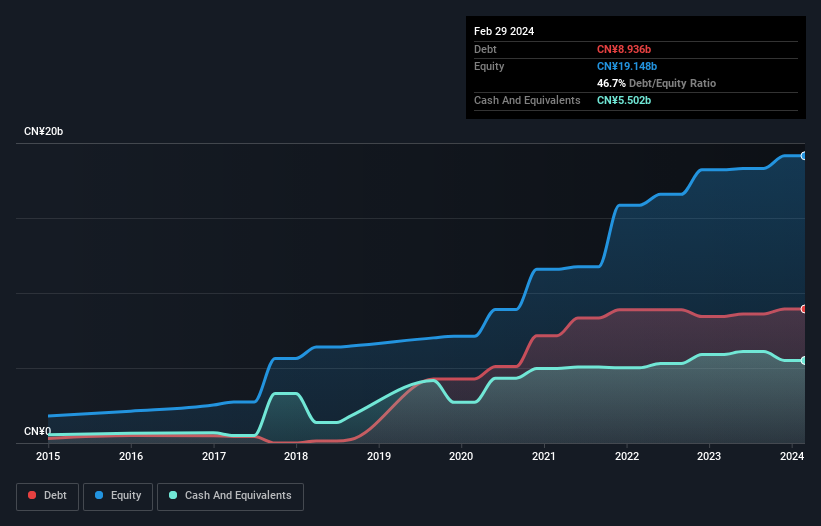- Hong Kong
- /
- Consumer Services
- /
- SEHK:839
Does China Education Group Holdings (HKG:839) Have A Healthy Balance Sheet?

Some say volatility, rather than debt, is the best way to think about risk as an investor, but Warren Buffett famously said that 'Volatility is far from synonymous with risk.' When we think about how risky a company is, we always like to look at its use of debt, since debt overload can lead to ruin. We can see that China Education Group Holdings Limited (HKG:839) does use debt in its business. But is this debt a concern to shareholders?
Why Does Debt Bring Risk?
Generally speaking, debt only becomes a real problem when a company can't easily pay it off, either by raising capital or with its own cash flow. Ultimately, if the company can't fulfill its legal obligations to repay debt, shareholders could walk away with nothing. However, a more common (but still painful) scenario is that it has to raise new equity capital at a low price, thus permanently diluting shareholders. Having said that, the most common situation is where a company manages its debt reasonably well - and to its own advantage. When we examine debt levels, we first consider both cash and debt levels, together.
Check out our latest analysis for China Education Group Holdings
How Much Debt Does China Education Group Holdings Carry?
You can click the graphic below for the historical numbers, but it shows that as of February 2024 China Education Group Holdings had CN¥8.94b of debt, an increase on CN¥8.43b, over one year. However, because it has a cash reserve of CN¥5.50b, its net debt is less, at about CN¥3.43b.

A Look At China Education Group Holdings' Liabilities
We can see from the most recent balance sheet that China Education Group Holdings had liabilities of CN¥7.49b falling due within a year, and liabilities of CN¥9.58b due beyond that. Offsetting this, it had CN¥5.50b in cash and CN¥125.0m in receivables that were due within 12 months. So it has liabilities totalling CN¥11.4b more than its cash and near-term receivables, combined.
This is a mountain of leverage relative to its market capitalization of CN¥12.3b. Should its lenders demand that it shore up the balance sheet, shareholders would likely face severe dilution.
We use two main ratios to inform us about debt levels relative to earnings. The first is net debt divided by earnings before interest, tax, depreciation, and amortization (EBITDA), while the second is how many times its earnings before interest and tax (EBIT) covers its interest expense (or its interest cover, for short). Thus we consider debt relative to earnings both with and without depreciation and amortization expenses.
While China Education Group Holdings's low debt to EBITDA ratio of 1.1 suggests only modest use of debt, the fact that EBIT only covered the interest expense by 5.7 times last year does give us pause. So we'd recommend keeping a close eye on the impact financing costs are having on the business. If China Education Group Holdings can keep growing EBIT at last year's rate of 16% over the last year, then it will find its debt load easier to manage. When analysing debt levels, the balance sheet is the obvious place to start. But ultimately the future profitability of the business will decide if China Education Group Holdings can strengthen its balance sheet over time. So if you want to see what the professionals think, you might find this free report on analyst profit forecasts to be interesting.
But our final consideration is also important, because a company cannot pay debt with paper profits; it needs cold hard cash. So the logical step is to look at the proportion of that EBIT that is matched by actual free cash flow. In the last three years, China Education Group Holdings created free cash flow amounting to 12% of its EBIT, an uninspiring performance. That limp level of cash conversion undermines its ability to manage and pay down debt.
Our View
Even if we have reservations about how easily China Education Group Holdings is capable of converting EBIT to free cash flow, its EBIT growth rate and net debt to EBITDA make us think feel relatively unconcerned. When we consider all the factors discussed, it seems to us that China Education Group Holdings is taking some risks with its use of debt. While that debt can boost returns, we think the company has enough leverage now. The balance sheet is clearly the area to focus on when you are analysing debt. But ultimately, every company can contain risks that exist outside of the balance sheet. To that end, you should be aware of the 2 warning signs we've spotted with China Education Group Holdings .
If, after all that, you're more interested in a fast growing company with a rock-solid balance sheet, then check out our list of net cash growth stocks without delay.
New: AI Stock Screener & Alerts
Our new AI Stock Screener scans the market every day to uncover opportunities.
• Dividend Powerhouses (3%+ Yield)
• Undervalued Small Caps with Insider Buying
• High growth Tech and AI Companies
Or build your own from over 50 metrics.
Have feedback on this article? Concerned about the content? Get in touch with us directly. Alternatively, email editorial-team (at) simplywallst.com.
This article by Simply Wall St is general in nature. We provide commentary based on historical data and analyst forecasts only using an unbiased methodology and our articles are not intended to be financial advice. It does not constitute a recommendation to buy or sell any stock, and does not take account of your objectives, or your financial situation. We aim to bring you long-term focused analysis driven by fundamental data. Note that our analysis may not factor in the latest price-sensitive company announcements or qualitative material. Simply Wall St has no position in any stocks mentioned.
About SEHK:839
China Education Group Holdings
An investment holding company, engages in the operation of private higher and secondary vocational education institutions in Mainland China and Australia.
Adequate balance sheet slight.


